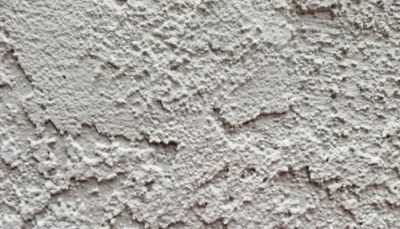Stucco or Plaster: How to Tell Them Apart & Choose One

If you’ve ever partaken in a stucco plaster debate, could you tell what makes the two different from one another? A lot of people can’t really tell the two apart, mainly because they’re very similar building materials.
However, there’s a stucco vs. plaster debate going on regarding whether both are interchangeable, and in short — they are not. In a plaster stucco showdown, what’s the better option for your property? Let’s find out how to make a distinction between them and what to consider before choosing one.
Stucco: What Is It & Where It’s Used
Stucco, also known as render, is a building material used on walls. Stucco is made of water, aggregates, and binder. When working with stucco, it’s essential to understand that it’s best applied when wet. Stucco gradually hardens until it reaches a point of very dense sturdiness.
In general, the word stucco originates from the Italian word for plaster. If you’ve never noticed before, a lot of house exteriors in the southwest U.S. are made of stucco, complemented by terracotta shingles. For years now, stucco has been used as an embellishing coating on both ceilings and walls (interior and exterior).
In theory, stucco is a cement-based wall cladding used to add structured finishes. One of the many perks of stucco is that it comes in many colors and textures. It breaks down into two main stucco systems: the 3-coat and 1-coat system. Due to its sturdiness and durability, stucco is a great option for hot and cold environments.
Furthermore, stucco comes in two different forms: synthetic and traditional. Traditional stucco contains sand, water, and lime. Synthetic stucco does not use cement and lime but acrylic resin to boost the resistance to water damage.
Plaster: What Is it & Where It’s Used
Usually made of lime/gypsum, water, and sand, plaster is a paste-like building material that’s used to coat ceilings, walls, and interior sections. As plaster is applied, it hardens while drying, just like stucco.
As a building technique, plastering is an ancient practice used to build homes, create art, and so on. Plaster is a material used to add a protective or decorative coating to ceilings and walls, as well as casting and molding ornamental features.
Based on what type of binder is used, and the environment of the application, there are several distinct plastering techniques.
- Lime-based plaster: In this technique, lime is the leading binder. It’s the most appropriate option for environments that see a lot of water.
- Gypsum plaster: This technique is mostly applied in building techniques that are more classic and require embellishments. Gypsum plaster is the technique you’ll see in historic and old buildings.
- Cement-lime plaster: This particular building technique combines Portland cement and lime and is used when resistance, sturdiness, versatility, and compactness are key.
Stucco vs Plaster: Key Differences
In practice, people often refer to stucco as the coating on the building’s exterior sections, whereas plaster is considered the coating of the interior walls. However, both plaster and stucco can be used internally and externally.
One major difference between stucco and plaster lies in the visual aspect. As a finish, plaster is smoother, and stucco is more roughly textured. When it comes to the components of both, one can safely say they’re more or less the same: clay/cement, lime, water, and sand (with the possibility of additives).
Compared to many paints, plaster is non-toxic and contains no VOCs (volatile organic compounds) or other hazardous components. Adding color to stucco or plaster is done by mixing all-natural pigments. In addition, using plaster in interior walls won’t generate toxic dust.
Stucco takes the lead when comparing plaster vs. stucco in terms of durability. Stucco is generally more durable than plaster. On the other hand, plaster offers more customization, whereas stucco is less flexible. For instance, builders put plaster in molds to create custom designs. With stucco, they won’t be able to do that since it’s more rigid and harsher.
Even though builders can use stucco and plaster interchangeably as indoor and outdoor finishes, they prefer stucco as an exterior building material and plaster as an indoor one.
Noteworthy Highlights
- Stucco is deemed more durable than plaster;
- Due to its rough texture, stucco isn’t the best option when doing custom designs;
- Put plaster in molds to create customizable designs;
- Plaster is a preferred choice for indoor projects, whereas stucco performs best as an outdoor finish;
- From a technical point of view, you can use both stucco and plaster outdoors and indoors;
- Price-wise, stucco is a bit more expensive than plaster.
Pros and Cons of Stucco
As mentioned, stucco consists of cement, sand, and lime-based components. Sometimes, fiberglass is added to increase its texture and rigidness (some building applications call for this).
Typically, you’ll find stucco on the exterior walls of residential buildings. Still, it isn’t strange for particular interior designs to include stucco in the interior walls of houses, especially those carrying a Mediterranean design staple.
Pros
- Long-lasting
- Can increase a property’s value
- Resistant to mold, rot, and mildew
- Fire-resistant
Cons
- It’s porous
- Tends to form dark spots
- Expensive
Pros and Cons of Plaster
The main feature of plaster is that it’s very flexible and can be used in almost every interior or exterior design. Unlike stucco, plaster is smooth and used to cover rough edges and/or uneven surfaces within buildings.
Pros
- Very tensile
- Resistant to wear and tear
- Great insulator and noise-blocker
- Highly versatile and customizable
Cons
- Not very resistant to water damage
- Can easily mold
- Can crack with age
Choosing One or the Other: Plaster vs. Stucco
Many homeowners do not pay much attention to the building materials when building their dream home simply because they leave it to the professionals to know what’s best. So, it’s only natural they won’t know the differences between cement plaster vs. stucco.
However, even though you trust the pros to do a stellar job, knowing your options and which building materials to choose for different purposes won’t hurt.
- Appearance: Looks-wise, plaster is more adaptable and versatile than stucco. If you want to do custom designs, choose plaster since stucco doesn’t perform well for customizations. On the other hand, stucco is a good choice if you prefer a rough texture on your interior walls.
- Versatility: By definition, both stucco and plaster are used in exterior and exterior designs. Yet, stucco is better as an exterior option due to its features. Since plaster is more delicate than stucco, using it on your exterior walls might not be a great idea.
- Durability: In terms of lasting, stucco takes the lead. A well-applied stucco can last way longer than plaster. On average, you can expect stucco to last for up to 50 years, given you’ve taken care of it well. On the other hand, plaster is a bit tricky. It will either last up to 70 years or begin to crumble after 20.
- Price: Cost-wise, stucco has a slightly higher price than plaster. On average, stucco costs $8 per square foot. To buy plaster, you’d pay approximately $2 and $10 per square foot. The discrepancy in the cost is due to the quality of each, the color, etc.
The Stucco Plaster Debate: Ultimate Explanation
Homeowners and construction professionals value both plaster and stucco for their sustainability, endurance, and aesthetics. Still, there’s more to these building materials than what meets the eye. For one, both are great paint alternatives that contain no toxins and are fairly easy to work with. Plus, both are eco-friendly building materials composed of components found in nature.
Stucco and plaster are more or less the same, with a few distinctions. In terms of composition, both include water, sand, and binder in their ingredient list. Looks-wise, plaster offers a smooth finish and can be placed into molds for custom designs. Stucco, however, is not so flexible.
As opposed to plaster, stucco feels rough to the touch and looks different than plaster. If you want the exterior of your property to be well-shielded against mold, water damage, and fire, choose stucco. If you’d rather have custom designs inside your property, go for plaster.
If you want to add value to your property, choose stucco — it’s a great curb appeal booster. Potential buyers will appreciate a well-made stucco when you decide to put your property on the market.
FAQs
Which is more expensive, plaster or stucco?
Stucco is a bit more expensive than plaster.
Does stucco increase home value?
A well-maintained stucco, plain or colored, is a great booster of the property’s curb appeal and really adds to the estate’s overall value.
What are the two types of stucco?
Stucco comes in two varieties: traditional and synthetic stucco.

